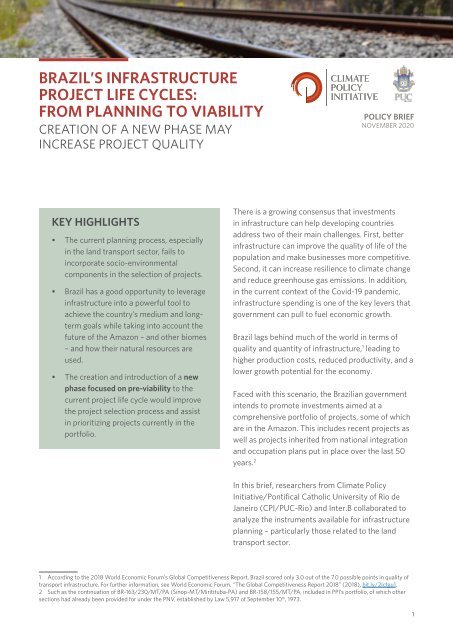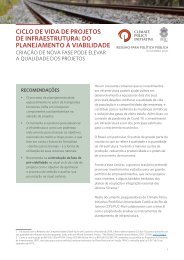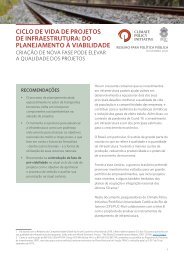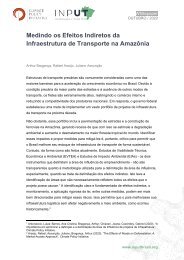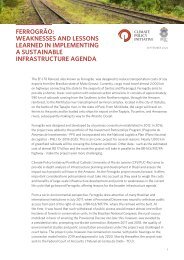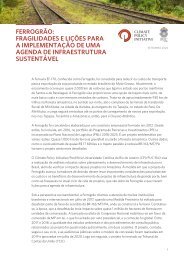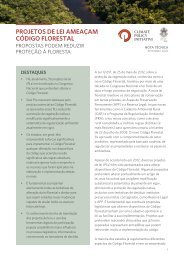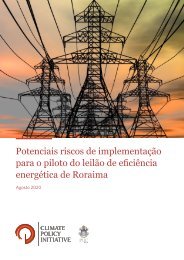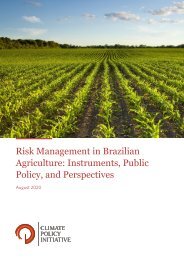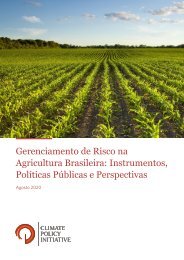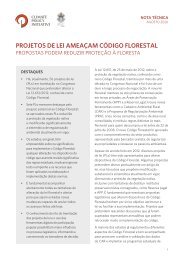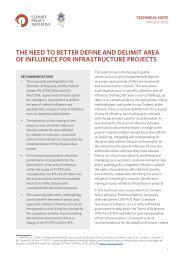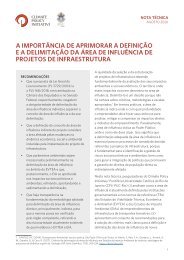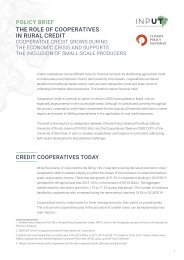Brazil’s Infrastructure Project Life Cycles: from Planning to Viability. Creation of a New Phase May Increase Project Quality
Create successful ePaper yourself
Turn your PDF publications into a flip-book with our unique Google optimized e-Paper software.
BRAZIL’S INFRASTRUCTURE<br />
PROJECT LIFE CYCLES:<br />
FROM PLANNING TO VIABILITY<br />
CREATION OF A NEW PHASE MAY<br />
INCREASE PROJECT QUALITY<br />
POLICY BRIEF<br />
NOVEMBER 2020<br />
KEY HIGHLIGHTS<br />
• The current planning process, especially<br />
in the land transport sec<strong>to</strong>r, fails <strong>to</strong><br />
incorporate socio-environmental<br />
components in the selection <strong>of</strong> projects.<br />
• Brazil has a good opportunity <strong>to</strong> leverage<br />
infrastructure in<strong>to</strong> a powerful <strong>to</strong>ol <strong>to</strong><br />
achieve the country’s medium and longterm<br />
goals while taking in<strong>to</strong> account the<br />
future <strong>of</strong> the Amazon – and other biomes<br />
– and how their natural resources are<br />
used.<br />
• The creation and introduction <strong>of</strong> a new<br />
phase focused on pre-viability <strong>to</strong> the<br />
current project life cycle would improve<br />
the project selection process and assist<br />
in prioritizing projects currently in the<br />
portfolio.<br />
There is a growing consensus that investments<br />
in infrastructure can help developing countries<br />
address two <strong>of</strong> their main challenges. First, better<br />
infrastructure can improve the quality <strong>of</strong> life <strong>of</strong> the<br />
population and make businesses more competitive.<br />
Second, it can increase resilience <strong>to</strong> climate change<br />
and reduce greenhouse gas emissions. In addition,<br />
in the current context <strong>of</strong> the Covid-19 pandemic,<br />
infrastructure spending is one <strong>of</strong> the key levers that<br />
government can pull <strong>to</strong> fuel economic growth.<br />
Brazil lags behind much <strong>of</strong> the world in terms <strong>of</strong><br />
quality and quantity <strong>of</strong> infrastructure, 1 leading <strong>to</strong><br />
higher production costs, reduced productivity, and a<br />
lower growth potential for the economy.<br />
Faced with this scenario, the Brazilian government<br />
intends <strong>to</strong> promote investments aimed at a<br />
comprehensive portfolio <strong>of</strong> projects, some <strong>of</strong> which<br />
are in the Amazon. This includes recent projects as<br />
well as projects inherited <strong>from</strong> national integration<br />
and occupation plans put in place over the last 50<br />
years. 2<br />
In this brief, researchers <strong>from</strong> Climate Policy<br />
Initiative/Pontifical Catholic University <strong>of</strong> Rio de<br />
Janeiro (CPI/PUC-Rio) and Inter.B collaborated <strong>to</strong><br />
analyze the instruments available for infrastructure<br />
planning – particularly those related <strong>to</strong> the land<br />
transport sec<strong>to</strong>r.<br />
1 According <strong>to</strong> the 2018 World Economic Forum’s Global Competitiveness Report, Brazil scored only 3.0 out <strong>of</strong> the 7.0 possible points in quality <strong>of</strong><br />
transport infrastructure. For further information, see World Economic Forum, “The Global Competitiveness Report 2018” (2018), bit.ly/2Icfgu1.<br />
2 Such as the continuation <strong>of</strong> BR-163/230/MT/PA (Sinop-MT/Miritituba-PA) and BR-158/155/MT/PA, included in PPI’s portfolio, <strong>of</strong> which other<br />
sections had already been provided for under the PNV, established by Law 5,917 <strong>of</strong> September 10 th , 1973.<br />
1
The analysis found that there is an opportunity <strong>to</strong> (i) enact a planning strategy that reflects a<br />
sustainable development model and includes decisions about the future <strong>of</strong> the Amazon and other<br />
biomes, and (ii) <strong>to</strong> introduce a pre-viability phase <strong>to</strong> improve the project selection process and<br />
assist in prioritizing projects currently in the portfolio.<br />
This analysis reveals that the newly enacted Brazilian National Development Strategy (Estratégia<br />
Federal de Desenvolvimen<strong>to</strong> para o Brasil – EFD), 3 despite stating that it is a long-term strategy, is<br />
actually a medium-term one given its eleven-year time period. Additionally, while it establishes<br />
general key index and target goals, they may not be enough <strong>to</strong> address critical issues, such as<br />
deforestation.<br />
Based on this analysis, the authors recommend the introduction <strong>of</strong> a planning strategy that<br />
reflects a sustainable development model and the demand for infrastructure services and<br />
underlying assets for the medium and long-term. The Amazon deserves a special chapter in such<br />
a strategy, given its position as the largest tropical forest in the world and its role as a provider <strong>of</strong><br />
essential ecosystem services for <strong>Brazil’s</strong> economy and society at large.<br />
To ensure greater integrity in the project selection process, the authors<br />
recommend introducing a new step between the planning and the viability<br />
analysis <strong>of</strong> large-scale greenfield infrastructure projects. They propose the<br />
creation <strong>of</strong> a pre-viability phase that would act as a filter <strong>to</strong> ensure that only<br />
viable projects move forward, avoiding an au<strong>to</strong>matic track between planning<br />
and viability phases. In addition, the proposed pre-viability stage would be<br />
instrumental in helping prioritize the projects in the current portfolio.<br />
OVERVIEW OF INFRASTRUCTURE PLANNING<br />
INSTRUMENTS<br />
The Federal Constitution states that a law should be drafted <strong>to</strong> “set the guidelines and basis for<br />
the planning <strong>of</strong> a balanced development process at the national level, which should incorporate<br />
and ensure compatibility with national and regional development plans”. 4 Such law, however,<br />
does not yet exist.<br />
In view <strong>of</strong> this, other instruments are currently used <strong>to</strong> indicate the Federal Government’s<br />
short and medium-term plans – particularly the recently enacted EFD, as well as plans drafted<br />
by sec<strong>to</strong>ral bodies and entities and budgetary instruments, mainly the Multi-Year Plan (Plano<br />
Plurianual – PPA).<br />
A brief description <strong>of</strong> existing national planning instruments is provided below.<br />
3 Federal Decree 10,531/2020, accessed November 6, 2020, bit.ly/2GPy1Ti.<br />
4 Art. 174, § 1, accessed <strong>May</strong> 13, 2020, bit.ly/38stzoE. The law shall establish the guidelines and basis for planning <strong>of</strong> the balanced national<br />
development, which shall embody and make the national and regional development plans compatible.<br />
2
BRAZILIAN NATIONAL DEVELOPMENT STRATEGY (EFD)<br />
The EFD is a medium-term planning instrument <strong>from</strong> 2020 <strong>to</strong> 2031. It comprises five dimensions:<br />
economic, institutional, infrastructure, environmental, and social. It replaced the National<br />
Strategy for Economic and Social Development (Estratégia Nacional de Desenvolvimen<strong>to</strong> Econômico<br />
e Social – ENDES) that also set a national strategy for the same period but was never published as<br />
an <strong>of</strong>ficial norm.<br />
The EFD maintained a very similar structure as the ENDES, identifying most <strong>of</strong> the same<br />
challenges and solutions. While the ENDES lacked any tangible parameters <strong>to</strong> ensure the<br />
strategy assessment, the EFD advanced by establishing general key indices and respective target<br />
goals for each dimension. By setting these key indices, however, the EFD may also fall short on<br />
some specific issues by failing <strong>to</strong> include deforestation and biomes sensitivities, critical fac<strong>to</strong>rs<br />
for assessing infrastructure in the Amazon.<br />
As a guiding document that focuses on macro-level issues, it does not include specific<br />
infrastructure projects or criteria for project selection; multi-year plans, annual budget laws, and<br />
sec<strong>to</strong>ral plans are responsible for including them.<br />
3
BOX 1. INFRASTRUCTURE DEVELOPMENT IN THE AMAZON<br />
The EFD sets “reducing illegal deforestation” as a challenge <strong>to</strong> be overcome by the Brazilian<br />
government, but it makes no explicit mention <strong>of</strong> the Amazon. Domestic and foreign inves<strong>to</strong>rs,<br />
however, understand the importance <strong>of</strong> the region and the ecosystem services it provides, and<br />
they have taken public stances vis-à-vis investment prospects in the region and in the country. 5,6,7<br />
Over recent years, a growing international movement has sought <strong>to</strong> define a development<br />
pathway with a socio-environmental focus. In 2019, the G-20 General Assembly approved<br />
voluntary recommendations for quality infrastructure with reference <strong>to</strong> socio-environmental<br />
principles, 8 and in January 2020 the World Economic Forum recognized sustainability as its<br />
core element. 9 Generally speaking, in 2020 the sustainability imperative in the social and<br />
environmental sphere has become part <strong>of</strong> the mainstream for businesses, inves<strong>to</strong>rs, political and<br />
economic leaders, and, more importantly, for new generations.The Amazon features prominently<br />
in global commitments and concerns. For Brazil, which is home <strong>to</strong> approximately 60% <strong>of</strong> the<br />
Amazon basin and has seen its deforestation rates grow, 10 the Amazon is a major focus <strong>of</strong><br />
policies for preserving the region <strong>from</strong> a socio-environmental standpoint. Therefore, controlling<br />
deforestation is not just crucial, it is also an objective <strong>to</strong> be achieved under the country’s<br />
international climate commitments 11 and its National Climate Change Policy 12 .<br />
<strong>Infrastructure</strong> services that provide water, sanitation, health, mobility, and electricity at the local<br />
level are essential for the people who inhabit the Amazon. The existence <strong>of</strong> local infrastructure<br />
also encourages farmers <strong>to</strong> adopt intensive land use practices by lowering transportation<br />
costs for inputs and products, and by providing access <strong>to</strong> technical assistance and electricity<br />
for potential processing operations, in addition <strong>to</strong> fostering a bioeconomy. As is well known,<br />
however, large infrastructure projects were one <strong>of</strong> the biggest drivers <strong>of</strong> deforestation in the<br />
Amazon in the past. Over 80% <strong>of</strong> forest conversions occurred along roads. 13,14 In addition, the<br />
road, energy, and mining sec<strong>to</strong>rs located in the Amazon basin, <strong>to</strong>gether, threaten more than 50%<br />
<strong>of</strong> all protected areas, including Conservation Units and Indigenous Lands. 15<br />
This is, therefore, an opportunity <strong>to</strong> reflect upon a development strategy for the country, with<br />
infrastructure as a powerful instrument <strong>to</strong> achieve national goals, while considering the future <strong>of</strong><br />
the Amazon and the way its natural resources are used.<br />
5 Gabriel Shinohara, “Em Carta, Ex-Ministros e Ex-Presidentes Do BC Cobram Desmatamen<strong>to</strong> Zero Na Amazônia e No Cerrado” (O Globo, July 14,<br />
2020), accessed July 14, 2020, glo.bo/3kl7mvf.<br />
6 Célia Froufe, “Investidores Ameaçam Sair Do Brasil Se Destruição Da Amazônia Não Parar, Diz Financial Times” (O Estado de São Paulo, June 23,<br />
2020), accessed July 14, 2020, bit.ly/3prvrEz.<br />
7 Assessoria Cebds, “Se<strong>to</strong>r Empresarial Cobra Agenda Sustentável Do Governo Brasileiro” (Conselho Empresarial Brasileiro Para o Desenvolvimen<strong>to</strong><br />
Sustentável, July 7, 2020), accessed July 14, 2020, bit.ly/2UeDSEC.<br />
8 Ministry <strong>of</strong> Finance <strong>of</strong> Japan, “G20 Principles for <strong>Quality</strong> <strong>Infrastructure</strong> Investment” (2019), accessed July 14, 2020, bit.ly/3ePrkNC.<br />
9 Marsh & McLennan, “Global Risks Report 2020” (Davos: World Economic Forum, 2020), accessed July 14, 2020, bit.ly/2Il6Fos.<br />
10 National Institute for Space Research, “The Estimate <strong>of</strong> the Rate <strong>of</strong> Clear-Cut Deforestation for the Legal Amazon in 2019 is 9,762 km²”, (2019),<br />
accessed July 14, 2020, bit.ly/36lBhhW.<br />
11 Ministério do Meio Ambiente, “Contribuição Nacionalmente Determinada”, accessed July 14, 2020, bit.ly/3kfB3O0.<br />
12 Federal Law Nº 12,187 (December 29, 2009), accessed July 14, 2020, bit.ly/3eJ4GWY.<br />
13 Sadia Ahmed, Carlos Souza, Julia Ribeiro, and Robert Ewers, “Temporal patterns <strong>of</strong> road network development in the Brazilian Amazon” (Regional<br />
Environmental Change, 2013, 13(5), 927-937), accessed July 14, 2020, bit.ly/36mhBua.<br />
14 Chris<strong>to</strong>pher Barber, Mark Cochrane, Carlos Souza, and William Laurance, “Roads, Deforestation, and the Mitigating Effect <strong>of</strong> Protected Areas in<br />
the Amazon” (Biological Conservation, 2014, 177(1) 203–209), accessed July 14, 2020, bit.ly/2IkyY6i.<br />
15 Amazon Network <strong>of</strong> Georeferenced Social and Environmental Information – RAISG, “Amazonía Bajo Presión” (2012, p.60), bit.ly/3eIKWml.<br />
4
SECTORAL PLANS<br />
Sec<strong>to</strong>ral plans, such as energy and transport, set the objectives, guidelines, principles, and<br />
instruments <strong>to</strong> be used in achieving the proposed results.<br />
The energy sec<strong>to</strong>r has the most experience in drafting plans. Every year since 2006, the Energy<br />
Research Office (Empresa de Planejamen<strong>to</strong> Energético – EPE) updates the Ten-Year Energy Plan<br />
(PDE) laying out the prospects for future expansions in the energy sec<strong>to</strong>r. In 2007, the EPE also<br />
drafted the 2030 National Energy Plan (Plano Nacional de Energia – PNE), the sec<strong>to</strong>r’s first longterm<br />
plan. The EPE is currently working on the 2050 PNE. In January 2020, it was decided that<br />
this plan would be updated every five years for the next 30 years. 16<br />
The energy sec<strong>to</strong>r is also more advanced when dealing with socio-environmental issues, as it<br />
was the first sec<strong>to</strong>r <strong>to</strong> decide that all PNE studies must take socio-environmental aspects in<strong>to</strong><br />
account. 17 Even more relevant is the requirement <strong>to</strong> identify non-variable fac<strong>to</strong>rs when analyzing<br />
different scenarios, aspects that must be taken in<strong>to</strong> account in all projections. With regard <strong>to</strong><br />
socio-environmental issues, these fac<strong>to</strong>rs relate <strong>to</strong> environmental pressures on energy production<br />
and use, as well as rising power consumption rates. The plan also suggests “conditioning<br />
investments in energy sec<strong>to</strong>r projects <strong>to</strong> longer and more rigorous assessment, licensing, and<br />
environmental moni<strong>to</strong>ring processes, with an impact on project implementation schedules and<br />
costs”. 18<br />
The land transport sec<strong>to</strong>r, in turn, has issued five sec<strong>to</strong>r plans since 2008, none <strong>of</strong> which has<br />
formally been revoked <strong>to</strong> date. These plans, were drawn up by different government agencies<br />
and there is no effective interface among them, making long-term planning difficult or perhaps<br />
impossible. Figure 1 illustrates the plans and time horizons for each one.<br />
Figure 1. Plans and Time Horizons for the Land Transport Sec<strong>to</strong>r<br />
Source: Climate Policy Initiative, 2018 19<br />
16 MME Ordinance Nº 6 (passed Jan. 7, 2020), accessed <strong>May</strong> 13, 2020, bit.ly/2Imz1Ps.<br />
17 Empresa de Pesquisa Energética, “Plano Nacional de Energia – 2050”, accessed July 22, 2020, bit.ly/3keTsun.<br />
18 Ministério de Minas e Energia, “Nota Técnica DEA 05/13 – Termo de Referência (TDR) para Elaboração do PNE 2050” (2013), bit.ly/3eJIiwA.<br />
19 Luiza An<strong>to</strong>naccio, Juliano Assunção, Maína Celidonio, Joana Chiavari, Cristina Leme Lopes, and Amanda Schutze, Ensuring Greener Economic<br />
Growth for Brazil (Rio de Janeiro: Climate Policy Initiative, 2018), bit.ly/2GMopZk.<br />
5
Considering that each plan has its own guidelines (with specific incentive structures and rules)<br />
and project portfolios, the overlap, and lack <strong>of</strong> coordination among them generates uncertainty<br />
regarding the incentives currently in effect.<br />
While none <strong>of</strong> the plans have been expressly revoked, the Federal Government is currently<br />
indicating that the National Logistics Plan (Plano Nacional de Logística – PNL) prepared by the<br />
<strong>Planning</strong> and Logistics Office (Empresa de Planejamen<strong>to</strong> e Logística – EPL) will be the plan <strong>to</strong> guide<br />
the policy on public works and concessions for the land transport sec<strong>to</strong>r.<br />
National Logistics Plan (PNL)<br />
The PNL was published in 2018 by the EPL with a time horizon up <strong>to</strong> 2025. A new PNL is<br />
expected with a time horizon <strong>of</strong> 2035. The plan reviews the guidelines <strong>of</strong> the National Transport<br />
Plan and other plans in the logistics sec<strong>to</strong>r, such as the National Waterway Integration Plan<br />
(Plano Nacional de Integração Hidroviária – PNIH) and the National Port Logistics Plan (Plano<br />
Nacional de Logística Portuária – PNLP). 20<br />
The goal <strong>of</strong> the PNL is <strong>to</strong> strike a balance among transport modalities, considering the relative<br />
efficiency <strong>of</strong> each one. Secondary objectives aim <strong>to</strong> lower carbon dioxide (CO 2<br />
) emissions and<br />
reduce cargo transportation costs.<br />
The PNL’s planning exercise was meant <strong>to</strong> pinpoint “bottlenecks” (i.e., markets where the supply<br />
<strong>of</strong> transport infrastructure fails <strong>to</strong> meet demand) by comparing the current scenario 21 <strong>to</strong> an<br />
optimized scenario (“2025 Scenario”) and using priority projects in the road, rail, and waterway<br />
sec<strong>to</strong>rs as a reference. A <strong>to</strong>tal <strong>of</strong> 40 projects were included in the PNL (31 road, eight rail, and<br />
one waterway project). 22 To be included in the PNL, projects had <strong>to</strong> have been on the agenda for<br />
execution when the plan was drawn up, and scheduled <strong>to</strong> be up and running by 2025.<br />
Based on these criteria, the following projects were considered: qualified projects under the<br />
Investment Partnerships Program (Programa de Parcerias de Investimen<strong>to</strong> – PPI), components <strong>of</strong><br />
the Avançar Program, current concession obligations, and capacity expansions in concessions<br />
subject <strong>to</strong> potential term extensions. The plan did not explicitly feature any socio-environmental<br />
criteria for project inclusion. It merely points out the possible impacts on CO 2<br />
emissions if the<br />
optimized scenario comes <strong>to</strong> pass. 23<br />
The EPL is currently preparing an update <strong>to</strong> the PNL, known as the 2035 PNL, which is expected<br />
<strong>to</strong> feature a chapter devoted <strong>to</strong> the socio-environmental components <strong>of</strong> infrastructure projects.<br />
As <strong>of</strong> yet, however, no announcement has been made about which components will be listed or<br />
the weights assigned <strong>to</strong> them in project selection as part <strong>of</strong> the sec<strong>to</strong>ral planning process.<br />
20 The drafting process for the PNL <strong>to</strong>ok in<strong>to</strong> consideration existing sec<strong>to</strong>ral plans tied <strong>to</strong> federal and state governments. In addition <strong>to</strong> the PNIH and<br />
PNLP, other references were: the PNLT; PHE; PELTs; and PNLI.<br />
21 The current scenario includes the main works in progress plus the ones that were expected <strong>to</strong> be completed by the end <strong>of</strong> 2018.<br />
22 Annex 1 includes the list <strong>of</strong> the projects included in the PNL. Furthermore, in addition <strong>to</strong> the projects considered under the “2025 Scenario”, a<br />
<strong>Project</strong> Portfolio was proposed with other strategic undertakings <strong>to</strong> resolve the remaining bottlenecks (especially in the road sec<strong>to</strong>r), since many<br />
<strong>of</strong> the initial bottlenecks were mitigated by increasing the supply <strong>of</strong> railroad transportation. As such, the Portfolio also included 23 other projects,<br />
including 19 focused on adapting road sections, two on highway construction, and two on railroad construction.<br />
23 The document also states that the new version <strong>of</strong> the PNL will include a cost-benefit analysis involving PAE and a socio-economic impact<br />
assessment. The PAE proposal is under development by the EPL and seeks <strong>to</strong> change the way the environmental variable fits in<strong>to</strong> strategic<br />
infrastructure planning, while taking the concept <strong>of</strong> AAE in<strong>to</strong> account. It also seeks <strong>to</strong> inform decision making on priority investments and provide<br />
additional legal, economic and technical security <strong>to</strong> project development in the realm <strong>of</strong> transport.<br />
6
BUDGETARY INSTRUMENTS<br />
Public expenditures are subject <strong>to</strong> budget restrictions. The Federal Constitution provides for three<br />
instruments for planning and authorizing expenses, namely: the Budget Guidelines Law (Lei de<br />
Diretrizes Orçamentárias – LDO), the Multi-Year Plan (Plano Plurianual – PPA), and the Annual<br />
Budget Law (Lei Orçamentária Anual – LOA). 24<br />
The PPA sets the guidelines, goals, and objectives <strong>of</strong> the Federal Government and its expenses. 25<br />
Based on the PPA, the LDO sets the goals and priorities for the following year and the spending<br />
cap for the legislative, executive, and judicial branches <strong>of</strong> government. LDO also lays out<br />
financing priorities for public banks and sets other provisions. The LOA takes the PPA and LDO<br />
in<strong>to</strong> consideration and sets the annual budget.<br />
The current PPA (<strong>from</strong> 2020 <strong>to</strong> 2023) 26 sets as one <strong>of</strong> its guidelines “increased private<br />
investments in infrastructure, guided by long-term planning coupled with less legal insecurity”. 27<br />
This showcases a concern with the infrastructure sec<strong>to</strong>r and the need for closer alignment with<br />
long-term plans, combined with legal frameworks that <strong>of</strong>fer more security <strong>to</strong> inves<strong>to</strong>rs.<br />
INTRODUCING A NEW STAGE BETWEEN THE PLANNING<br />
AND VIABILITY PHASES<br />
<strong>Infrastructure</strong> projects that undergo concessions must go through different stages before<br />
beginning operation. However, recurrent flaws in Technical, Economic and Environmental<br />
Feasibility Studies (Estudos de Viabilidade Técnica, Econômica e Ambiental – EVTEA) fail <strong>to</strong> prevent<br />
poorly-designed projects <strong>from</strong> moving forward (i.e., projects that are economically unsustainable<br />
without l<strong>of</strong>ty government subsidies, whose execution is highly complex, or which cause<br />
negative socio-environmental impacts). These projects tend <strong>to</strong> become assets that provide low<br />
return rates <strong>to</strong> society and, in extreme cases, may even be abandoned. This means that early<br />
stages currently lack the proper reviews <strong>to</strong> prevent the misallocation <strong>of</strong> investments with high<br />
opportunity costs.<br />
To improve infrastructure planning and development, researchers <strong>from</strong> CPI/PUC-Rio and Inter.B<br />
propose the creation <strong>of</strong> a pre-viability analysis stage. This stage would serve as an administrative<br />
rite capable <strong>of</strong> reducing uncertainties throughout the planning cycle, and introducing more<br />
granular reviews as the projects progress through the various stages <strong>to</strong> prevent low-quality<br />
projects (due <strong>to</strong> inertia or political economy) <strong>from</strong> reaching a point <strong>of</strong> almost no return. This<br />
procedure would also allow for the coordination <strong>of</strong> government efforts and the terri<strong>to</strong>rial<br />
contextualization <strong>of</strong> the project, which are necessary fac<strong>to</strong>rs for ensuring that projects deemed<br />
viable are well structured.<br />
24 1988 Federal Constitution, Art. 165.<br />
25 Câmara dos Deputados, “Orçamen<strong>to</strong> da União”, accessed <strong>May</strong> 12, 2020, bit.ly/2Iq7AEr.<br />
26 The multi-year nature <strong>of</strong> the PPA is <strong>of</strong>ten criticized for failing <strong>to</strong> include yearly reviews. There is even a PEC before the Federal Senate that seeks<br />
<strong>to</strong> extinguish the PPA and make the LOA and the LDO the primary instruments for regulating the federal budget and, in doing so, outline priority<br />
infrastructure project and other objectives.<br />
27 Federal Law Nº 13,971/2019, accessed <strong>May</strong> 12, 2020, bit.ly/38oAboe. Annexes <strong>to</strong> the law are available at: bit.ly/36qs7AR.<br />
7
INTRODUCTION TO THE PRE-VIABILITY PHASE<br />
This pre-viability phase should be instituted for large greenfield infrastructure projects <strong>to</strong> be<br />
granted under concession. It contains two stages: (i) the description <strong>of</strong> the project, in which a<br />
questionnaire (see Box 2) must be answered without requiring in-depth studies <strong>to</strong> pinpoint firs<strong>to</strong>rder<br />
obstacles including socio-environmental risks and <strong>to</strong> assess whether these obstacles are<br />
avoidable (or not), and (ii) a socio-environmental complexity analysis (see Box 3) that serves <strong>to</strong><br />
anticipate discussions that are currently only addressing the viability phase by the EVTEA and by<br />
the EIA.<br />
BOX 2. STRUCTURING QUESTIONNAIRE FOR THE PRE-VIABILITY<br />
ANALYSIS STAGE<br />
1. What service does the project seek <strong>to</strong> provide? What is the reason for the project?<br />
2. What problem does the project seek <strong>to</strong> solve? What is the cause or condition that<br />
motivates the existence <strong>of</strong> the project? What is the expected impact?<br />
3. Are the project objectives clear and measurable?<br />
4. Are the project’s objectives clearly related <strong>to</strong> the government’s long-term planning?<br />
5. Is the project synergistic with – or antagonistic <strong>to</strong> – other projects?<br />
6. Are there other projects that provide or seek <strong>to</strong> provide the same type <strong>of</strong> service or<br />
solve the same problem? Do they share the same objectives?<br />
7. Are there other works (completed or halted) that provide or seek <strong>to</strong> provide the same<br />
type <strong>of</strong> service or solve the same problem? Do they share the same objectives?<br />
8. Does the project’s functionality depend on other ventures? For example, ports require<br />
transportation logistics; power generation plants require transmission networks.<br />
9. Which public and/or private entities may react in such a way as <strong>to</strong> impact the<br />
project’s viability?<br />
10. Considering the entities identified above, what possible reactions <strong>to</strong> the project can<br />
be expected (e.g., price reductions, improved service quality, expansions and/or<br />
upgrades <strong>to</strong> existing infrastructure, etc.)?<br />
Once the project has been evaluated using the structuring questionnaire, a socio-environmental<br />
complexity analysis <strong>of</strong> the project should be carried out <strong>to</strong> (re)validate the degree <strong>of</strong> execution<br />
viability. The socio-environmental complexity analysis starts by identifying the geographical<br />
areas directly and indirectly affected by the project and organizes a set <strong>of</strong> questions based on<br />
three axes: terri<strong>to</strong>rial, environmental, and social governance (Box 3). This analysis would draw<br />
upon secondary information <strong>to</strong> answer questions that, without requiring the production <strong>of</strong> new<br />
knowledge, address critical points that help ascertain a given project’s viability.<br />
8
BOX 3. SOCIO-ENVIRONMENTAL COMPLEXITY ANALYSIS<br />
Terri<strong>to</strong>rial Governance<br />
1. Are there environmental agencies working in the area where the project will be developed?<br />
2. Will the project be developed in an urbanized area?<br />
3. Is the area where the project will be developed close <strong>to</strong> highways or railroads? Is it connected<br />
<strong>to</strong> a mode <strong>of</strong> transportation? To what degree (i.e., is the interconnection dense, medium, or<br />
marginal)?<br />
4. Are there other infrastructure projects under development in nearby regions? If so, were there<br />
any execution-related conflicts (e.g., regarding expropriations, local communities, lawsuits,<br />
etc.)? How were these conflicts resolved (parties involved, court decisions, local agreements,<br />
etc.)?<br />
5. Are there other future infrastructure projects expected in or near the project region?<br />
6. Does the area where the project will be developed have a his<strong>to</strong>ry <strong>of</strong> social conflict?<br />
7. What are the government plans (at the municipal, state, and federal levels) for the area where<br />
the project will be developed?<br />
8. What is the fiscal situation <strong>of</strong> local governments in the cities affected by the development <strong>of</strong><br />
the project?<br />
Environmental Governance<br />
1. Is the project located in a strategic, environmentally fragile area?<br />
2. Is the project located in areas with relevant natural resources?<br />
3. Will the project have a relevant impact on an ecosystem or watershed (e.g., land use changes,<br />
water cycle changes, water consumption, etc.)? The effects do not have <strong>to</strong> be described in<br />
detail.<br />
4. Will the project be developed in an area with endangered species?<br />
5. Are there technical and locational alternatives (superior or equivalent) <strong>from</strong> an environmental<br />
component perspective?<br />
6. Does the project entail direct or indirect deforestation?<br />
7. Are there any projects or undertakings that could enhance or mitigate potential<br />
environmental impacts?<br />
8. Does the project entail extensive use <strong>of</strong> water resources?<br />
9. In the case <strong>of</strong> rivers, will the project have an impact downstream?<br />
10. Could the project generate competition for water use?<br />
11. Does the project directly or indirectly contribute <strong>to</strong> CO 2<br />
and/or greenhouse gas emissions?<br />
12. Does the project cause the release <strong>of</strong> sewage and other solid, liquid, or gaseous waste,<br />
flooding, silting, erosion, landfills?<br />
9
Social Governance<br />
1. Is the project located in, or in close proximity <strong>to</strong>, indigenous communities, quilombolas or<br />
other traditional populations?<br />
2. Does the project affect, directly or indirectly, indigenous communities, quilombolas or<br />
archaeological heritage sites?<br />
3. Are there technical and locational alternatives <strong>from</strong> a social component perspective?<br />
4. Does the project require expropriation?<br />
5. Does the project require the terri<strong>to</strong>ry be urbanized, temporarily or permanently?<br />
6. Is the project expected <strong>to</strong> provide social benefits? What is the nature <strong>of</strong> those benefits? Are<br />
they quantifiable?<br />
The complexity analysis creates an extra review that adds greater rationality <strong>to</strong> the process, by<br />
excluding projects that, at first sight, are deemed unsustainable – either because they are not<br />
bankable or because they provide low or negative returns <strong>to</strong> society – as well as those that are<br />
inconsistent with the development strategies championed by the country. Furthermore, this step<br />
imposes greater granularity and rigor in subsequent analyses, as it is based on a set <strong>of</strong> questions<br />
whose answers will serve as starting points or grounds for further analyses. Such analyses, by<br />
design, must be more rigorous, granular, and based on new data. In principle, the more complex<br />
the project – or the greater terri<strong>to</strong>rial scale or socio-environmental impact it has – the more<br />
useful the proposed methodology would be and the more desirable its adoption becomes.<br />
Figure 2 (below) illustrates the proposed concept <strong>of</strong> a planning cycle as described here, with the<br />
introduction <strong>of</strong> the pre-viability phase.<br />
10
Figure 2. Introduction <strong>of</strong> the Pre-<strong>Viability</strong> <strong>Phase</strong><br />
Source: Inter.B, 2020<br />
11
CONCLUSION<br />
Despite excess demand for infrastructure investments in Brazil, there are still structural flaws in<br />
the administration <strong>of</strong> public or government-funded investments. This weakness in investment<br />
governance reflects, <strong>to</strong> a large extent, a lack <strong>of</strong> medium and long-term planning in the country,<br />
especially in the land transport sec<strong>to</strong>r, in a way that fails <strong>to</strong> ensure greater project integrity and<br />
rationality. The importance <strong>of</strong> a new plan is clear: it is needed <strong>to</strong> make new projects feasible for<br />
the economy <strong>to</strong> recover after the pandemic, <strong>to</strong> improve the well-being <strong>of</strong> the population, <strong>to</strong> make<br />
businesses more competitive, and <strong>to</strong> prepare the country, its cities, and structures <strong>to</strong> deal with<br />
the climate crisis while contributing <strong>to</strong> the reduction <strong>of</strong> greenhouse gas emissions.<br />
This analysis proposes a new phase in the current project life cycle that filters projects<br />
prior <strong>to</strong> the viability phase in order <strong>to</strong> exclude those that are not economically, socially, and<br />
environmentally sustainable based on a rigorous analysis using secondary data. The process<br />
also allows projects <strong>to</strong> be prioritized at a stage when sunk costs are still limited. The pre-viability<br />
phase would play a crucial role in preventing infeasible or low-viability projects <strong>from</strong> reaching the<br />
bidding phase only <strong>to</strong> be excluded by government decisions or as a result <strong>of</strong> an empty bidding<br />
process. This will make the business environment more secure and reduce transaction costs in<br />
the sec<strong>to</strong>r. Lastly, the introduction <strong>of</strong> a pre-viability phase would help the government prioritize<br />
projects already in its portfolio.<br />
Given the vital ecological role <strong>of</strong> the Amazon region, it is imperative <strong>to</strong> measure the socioenvironmental<br />
risks <strong>of</strong> infrastructure projects and assess the extent <strong>to</strong> which they can be<br />
prevented or mitigated. The need <strong>to</strong> introduce a pre-viability phase is even more pressing in a<br />
sensitive environment like the Amazon and is meant <strong>to</strong> minimize the likelihood <strong>of</strong> damage <strong>to</strong> the<br />
biome, high (and avoidable) ecosystem costs and first-rate impacts on reputation.<br />
AUTHORS<br />
JOANA CHIAVARI<br />
Associate Direc<strong>to</strong>r, Climate Law and Governance, CPI/PUC-Rio<br />
joana.chiavari@cpiglobal.org<br />
ANA CRISTINA BARROS<br />
Senior Advisor, CPI/PUC-Rio<br />
LUIZA ANTONACCIO<br />
Legal Analyst, Climate Law and Governance, CPI/PUC-Rio<br />
CLÁUDIO FRISCHTAK<br />
President, Inter.B<br />
Suggested Citation<br />
CHIAVARI, Joana; ANTONACCIO, Luiza; BARROS, Ana Cristina; FRISCHTAK, Cláudio. Policy Brief. <strong>Brazil’s</strong><br />
<strong>Infrastructure</strong> <strong>Project</strong> <strong>Life</strong> <strong>Cycles</strong>: <strong>from</strong> <strong>Planning</strong> <strong>to</strong> <strong>Viability</strong>. <strong>Creation</strong> <strong>of</strong> a <strong>New</strong> <strong>Phase</strong> <strong>May</strong> <strong>Increase</strong> <strong>Project</strong> <strong>Quality</strong>.<br />
Rio de Janeiro: Climate Policy Initiative, 2020.<br />
NOVEMBER 2020<br />
Climate Policy Initiative (CPI) is an analysis and advisory organization with deep expertise in finance and policy. Our mission is <strong>to</strong> help<br />
governments, businesses, and financial institutions drive economic growth while addressing climate change. CPI’s Brazil program partners<br />
with the Pontifical Catholic University <strong>of</strong> Rio de Janeiro (PUC-Rio). This work is funded by Gordon and Betty Moore Foundation. CPI’s<br />
publication do not necessarily represent the view <strong>of</strong> its funders and partners.<br />
www.climatepolicyinitiative.org<br />
Content licensed under Creative Commons Attribution 4.0 International. The texts in this publication may be reproduced in whole<br />
or in part provided that the source and the respective authors are cited.<br />
12


